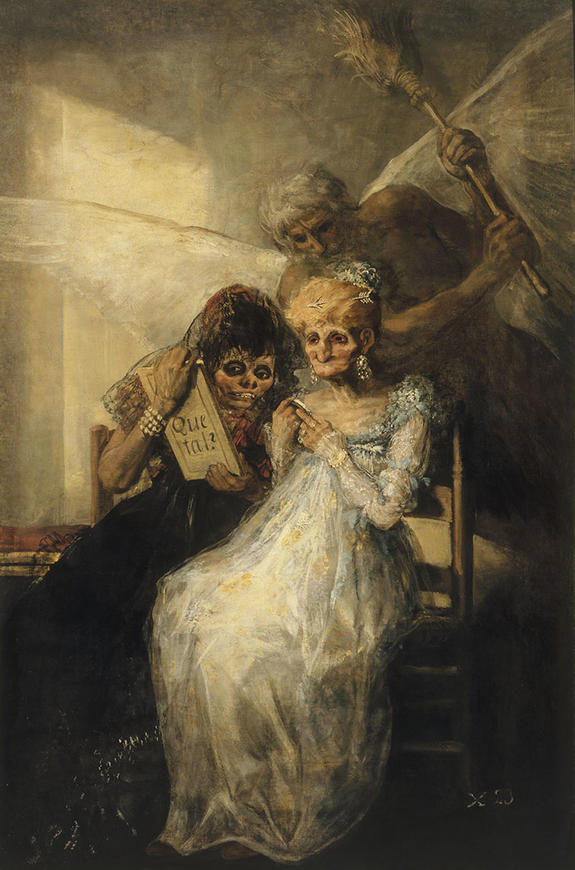An aristocrat and her servant sit alongside one another. The noblewoman holds in her hands a small object which is probably a portrait of herself as a young girl. Her servant passes her what appears to be a mirror, inscribed with the Spanish words "Qué tal?" ("How's it going?") The tone is set. Goya is mocking these ladies by asking them how they are when they are visibly at death's door. One has a toothless mouth, the other hollow eyes. They already resemble skeletons, despite their beautiful outfits!
This type of painting is called a Vanitas. It is an image intended to remind viewers that youth is merely a transitory state.
Even more surprising, a third figure is preparing to strike them with a broom. It is Chronos, the god of time. And what will happen? They might collapse into dust, they are so old!
The arrow worn by the aristocrat identifies her as the Queen of Spain, Maria Luisa. Goya painted her portrait in a more consensual style several years earlier, depicting her with the same jewellery.
This work has had an extraordinary history. It was bought by King Louis Philippe of France in 1836 for the Spanish gallery in the Louvre. When the sovereign fled into exile in England he took his collection, which was later sold to a collector. The painting was bought by the Museum of Lille in 1874. The inscription "X 23", in the bottom-right of the painting, was put there by Xavier Goya, the artist's son, who numbered several of his father's works in the same way.
Inv. P.50

An aristocrat and her servant sit alongside one another. The noblewoman holds in her hands a small object which is probably a portrait of herself as a young girl. Her servant passes her what appears to be a mirror, inscribed with the Spanish words "Qué tal?" ("How's it going?") The tone is set. Goya is mocking these ladies by asking them how they are when they are visibly at death's door. One has a toothless mouth, the other hollow eyes. They already resemble skeletons, despite their beautiful outfits!
This type of painting is called a Vanitas. It is an image intended to remind viewers that youth is merely a transitory state.
Even more surprising, a third figure is preparing to strike them with a broom. It is Chronos, the god of time. And what will happen? They might collapse into dust, they are so old!
The arrow worn by the aristocrat identifies her as the Queen of Spain, Maria Luisa. Goya painted her portrait in a more consensual style several years earlier, depicting her with the same jewellery.
This work has had an extraordinary history. It was bought by King Louis Philippe of France in 1836 for the Spanish gallery in the Louvre. When the sovereign fled into exile in England he took his collection, which was later sold to a collector. The painting was bought by the Museum of Lille in 1874. The inscription "X 23", in the bottom-right of the painting, was put there by Xavier Goya, the artist's son, who numbered several of his father's works in the same way.
Inv. P.50